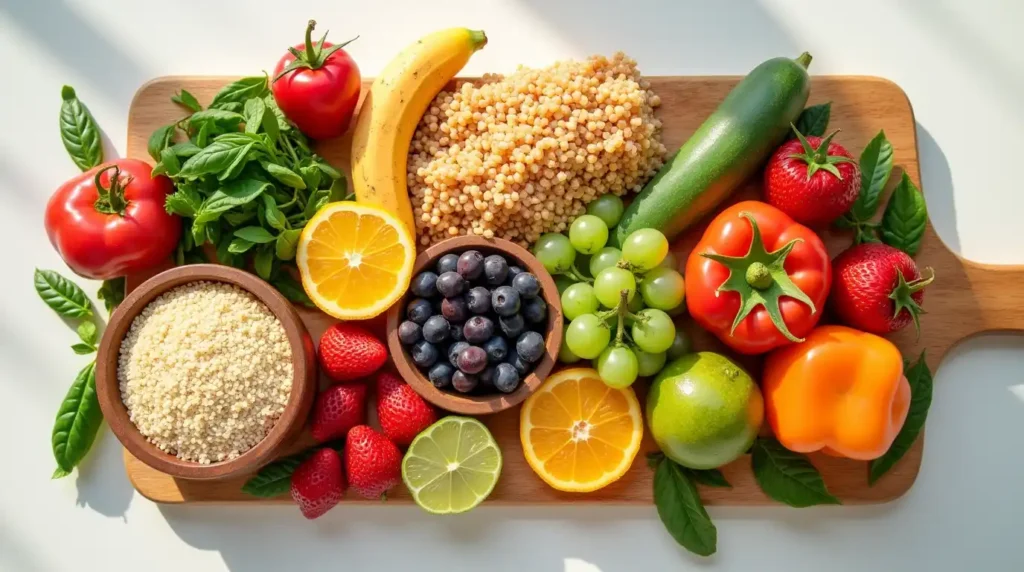Calorie Needs & BMR Calculator
Enter your details to discover your daily needs!
Your Results
Basal Metabolic Rate (BMR)
The calories your body burns at complete rest.
Total Daily Energy Expenditure (TDEE)
The calories needed to maintain your activity level.
Recommendation Based on Your Goal
Suggested Macro Breakdown:
Daily Nutrition Targets
Fun fact: 80% of women over 40 benefit from adjusting their calorie intake for energy!
How to Use This Daily Calorie Calculator to Boost Energy and Balance Hormones After 40
This calorie and BMR calculator for women is essential. As women enter their 40s and beyond, their metabolism, hormones, and energy levels begin to shift.
The approach that once worked for maintaining weight or feeling energized might no longer be effective.
That’s why understanding your Basal Metabolic Rate (BMR) and Total Daily Energy Expenditure (TDEE) is not just helpful—it’s essential.
This calculator is designed specifically for women who want to take control of their health through personalized nutrition based on science.
Below, we explain exactly how this tool works, why it matters, and how to make the most of your results.
What Is BMR and Why Does It Matter After 40?
Your Basal Metabolic Rate (BMR) represents the number of calories your body burns at complete rest—just to maintain life functions like breathing, circulation, and cell production. It’s the foundation of your energy needs.
As you age, particularly after 40, your BMR naturally declines. This is due to:
Loss of lean muscle mass
Hormonal changes (especially estrogen and thyroid shifts)
Slower cellular function
For women over 40, estimating BMR accurately is key to avoiding unintentional weight gain or energy slumps.
Our calculator uses the Mifflin-St Jeor Equation, which is considered the most accurate method by dietitians and metabolic experts. It takes into account your weight, height, age, and sex to estimate your BMR in real-time.

What Is TDEE and How Is It Calculated?
Once your BMR is known, we multiply it by a factor based on your physical activity level to calculate your Total Daily Energy Expenditure (TDEE). This gives you a realistic estimate of how many calories you burn per day.
Here’s a quick breakdown of the activity multipliers:
| Activity Level | Description | Multiplier |
|---|---|---|
| Sedentary | Little to no exercise | 1.2 |
| Lightly Active | Light exercise 1–3 days/week | 1.375 |
| Moderately Active | Moderate exercise 3–5 days/week | 1.55 |
| Very Active | Hard exercise 6–7 days/week | 1.725 |
| Extra Active | Daily intense training or physical job | 1.9 |
By combining your BMR with your actual activity, you get a tailored number that reflects your lifestyle, not just your resting metabolism.
Setting Your Goal: Lose Fat, Maintain Weight, or Boost Energy?
This is where personalization makes a big difference. Our calculator adjusts your recommended calorie intake based on your desired goal:
Weight loss: A safe, sustainable deficit (usually 500 calories less than your TDEE)
Maintenance: Exactly your TDEE
Energy boost / Muscle gain: A small surplus (typically +250–300 calories)
👉 This precision is important. Eating too few calories can slow your metabolism even further and disrupt hormones like cortisol, insulin, and leptin. Eating too much can lead to unwanted fat gain, especially around the abdomen due to estrogen decline.
Why Calorie Needs Change After 40
There are biological reasons your body behaves differently in your 40s and 50s compared to your 20s or 30s:
Estrogen Decline: Low estrogen impacts how your body stores fat and how sensitive it is to insulin.
Thyroid Slowdown: The thyroid, your metabolic regulator, tends to decrease its output with age.
Muscle Loss (Sarcopenia): You naturally lose muscle with age, unless you actively work to maintain it.
Increased Stress: Chronic stress can increase cortisol, leading to fat storage and energy crashes.
Understanding your calorie baseline is the first step to adapting intelligently to these shifts.
How to Use Your Results for Maximum Benefit
Once you’ve used the calculator, here’s what to do with the numbers:
1. Track Your Intake
Use a food-tracking app like MyFitnessPal, Cronometer, or LoseIt to align your actual intake with your TDEE or goal-based target.
2. Focus on Nutrient Quality
Not all calories are equal. Choose:
Protein-rich foods to maintain muscle and support hormones
Healthy fats for brain and hormone health
Complex carbs to support energy and sleep quality
👉 Want help planning macros? Try our Macro Nutrient Calculator next.
3. Adjust Based on Progress
Use your calorie range as a flexible guide, not a rigid rule. If you’re not seeing results after 2–3 weeks:
Reassess your activity level
Look for hidden calories or underreporting
Make sure stress and sleep aren’t sabotaging your progress

Common Myths About Calories for Women Over 40
Myth 1: Eating less is always better.
Too much restriction leads to fatigue, hormonal imbalance, and muscle loss.
Myth 2: Metabolism can’t change.
With strength training, protein-rich meals, and proper sleep, your metabolism can improve—even after menopause.
Myth 3: All calories are equal.
A 1500-calorie diet made of whole foods nourishes you very differently than 1500 calories of sugar and processed snacks.
From Calories to Lifestyle: The Bigger Picture
While knowing your BMR and TDEE is critical, it’s only one part of the energy puzzle. For sustainable results, combine this knowledge with:
🧘♀️ Stress management
💤 Sleep optimization
🍽️ Balanced macros
🏋️♀️ Regular resistance training
🕒 Circadian rhythm alignment
Our full suite of tools can guide you on this journey—check out the Sleep Quiz, Stress Level Assessment, and Insulin Resistance to gain deeper insight into your health.
Final Thoughts: You Deserve Tailored Nutrition
You’re not broken. Your body just needs a new strategy that honors the changes of midlife.
With this calorie calculator, you’re no longer guessing. You’re informed, empowered, and ready to fuel your body with purpose.
Take the next step and use your numbers to build a sustainable eating plan that supports your energy, hormones, and well-being.

